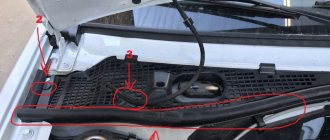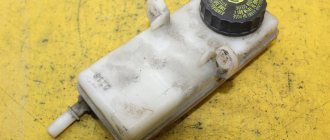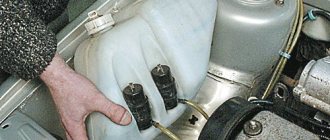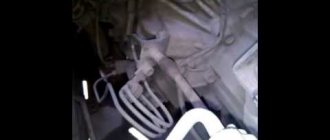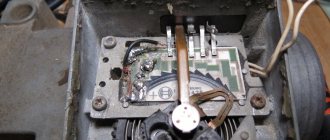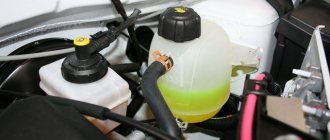Water froze in the washer reservoir: what to do
If the water in the windshield washer reservoir is frozen, there is no need to panic. Nothing terrible or irreparable happened. First of all, you need to assess the scale of the problem:
- how much frozen washer fluid is in the tank;
- How frozen the system is (is there ice in the motor and lines).
First, check the ice level in the tank. This can often be done visually by simply looking into the plug or at the level indicator. But in some cars the tank is hidden from view. Then you will need to acquire some thin and elastic metal object to launch it into the tank through the neck. An oil dipstick may be useful for this procedure. Just before immersing it in the tank you need to wipe it free of oil.
We feel and disconnect the lines connecting the motor and the injectors on the hood. Windshield washer lines are usually attached to the inside surface of the hood. A good sign is if the liquid in the tubes is not frozen. The mains are frozen - only heating with heat from outside will help.
Let's try spraying it on the glass. If the motor does not work, that is, when you press the washer lever or button, you do not hear a characteristic buzzing sound, then the system is completely frozen. In this case, it is highly recommended not to try to turn the motor. It can simply fail.
After the evaluation procedures, we select one of the most suitable methods for defrosting the water in the tank.
What not to do if the liquid is frozen
Warming up windshield washer fluid is a labor-intensive procedure that requires great care and compliance with safety precautions. When heating a frozen antifreeze, you must not:
- create strong temperature changes so as not to damage the components of the glass washing system (the use of boiling water, open fire, and strong heat is excluded);
- if the windshield washer reservoir is located above the wing of the car, prolonged warming up of the engine will not help - you will only burn the fuel: combined heating methods should be used here;
- All stages of heating the anti-freeze should be performed slowly and with pauses so as not to damage the frozen pump (impeller and washer pump motor).
Causes of freezing
First, you need to understand the reasons why car windshield washer nozzles freeze. This will largely make it clear how to avoid recurrence of similar situations in the future.
Icing that blocks the operation of the nozzles can occur in the nozzles, tubes, near the sprayer, or at the outlet of the spraying devices. Although in fact this is not of fundamental importance. In any case, the ice blocked the passage of fluid. Therefore, pressing the button to spray the washer and clean the windshield will not work.
There are several reasons why these same washer nozzles freeze on your car, ensuring the cleanliness of the windshield.
- Application of water. In order to save money, the motorist fills the tank with ordinary or distilled water, rather than using a special washer fluid. It is important to understand that in winter you need a liquid that will not freeze at the first drop in temperature below 0 degrees Celsius. Special components used in anti-freeze devices allow them to maintain a liquid state at fairly low temperatures. Ordinary water crystallizes already at 0 degrees Celsius.
- Low quality anti-freeze. Unfortunately, finding a good anti-freeze product is not so easy now. Try to contact trusted and reliable stores. Well-known brands are often counterfeited, and some liquids of dubious origin may not correspond to the stated characteristics stated on the label.
- Low temperature. Everyone has their limit. Frost resistance of anti-freeze is no exception. Even the highest quality liquids can freeze if the temperature drops below -15 or -20 degrees Celsius. So the only thing that will help here is a heated garage, in which the car is left overnight.
When faced with a similar situation, it is worth thinking about how to get out of it and what method of normalizing the operation of windshield washer nozzles is best to use.
Logical methods for defrosting anti-freeze in a tank
- Pour Aseptolin into the washer fluid reservoir (can be found in a pharmacy in a volume of 100 ml). In fact, it is almost pure alcohol, but drinking it is strictly prohibited, it is only for external use. For additional effect, it is advisable that the tubes with alcohol be warm. The price of one tube at the end of 2022 is 50 rubles. You will have to fill 2-3 tubes per liter of water in the tank. If you have anti-freeze in the tank (and not water) and the air temperature is not very low, then you can cope with a couple of tubes.
- Pour anti-freeze concentrate -80 into the tank. This is a rather expensive solution to the problem, since the price of one liter of this liquid exceeds 200 rubles. It is recommended to pour this liquid warm; you can warm it in a water bath, this way you can achieve the best effect. The amount of liquid to be filled depends on the volume of frozen washer fluid in the tank.
- Pour heated good anti-freeze -30 into the tank. It is advisable to heat it above 40 degrees before pouring so that the result is most effective. The amount of liquid to be filled depends on the volume of frozen liquid in the tank.
All methods involving pouring melting liquid can be combined with pumping out the washer fluid from the tank. Those. pour in warm anti-freeze, it melts some of the water. Next, use a hose or a “sprinkler from a bottle” (a syringe or whatever) to pump out the melted liquid to the maximum. We warm up the antifreeze again and fill it again. We repeat the process until all the frozen liquid comes out. If the liquid comes out naturally, then drain it onto the windshield and replace it with high-quality anti-freeze.
- Drive the car into a warm parking lot for a few hours. This is also a working method for cities with warm underground parking lots, but, unfortunately, this is not possible in all cities.
- Take your car to a warm car wash. This is one of the surest decisions, since a warm room + water above 0 degrees will easily melt the ice in the nozzles and pipes under the hood; in some cases there are washes with warm water. Some of the washer fluid in the reservoir will be melted by the heat of the engine, but this may not happen in all cases. There are situations when the washer tank is located in the bumper or behind the engine shield, and the engine heat does not reach there. To enhance the effect, you can add aseptolin or medical alcohol to the tank before going to the car wash. It is advisable that the car spends about 20-30 minutes in the washing area, this is a wash with foam + cleaning of the interior.
- Start the car and cover the hood with a blanket. About 20 minutes after the engine reaches operating temperature, the water in the tank will begin to drain + the ice will melt in the tubes going to the injectors. If the ambient temperature is below 15 degrees, then this activity may take a lot of time. If you have a diesel engine, this will not help you.
Heat with a lamp
This method goes well with defrosting the tank with non-freezing liquid. Pour it into the tank as described in the previous paragraph. Then take a compact lamp and attach it to the battery. It needs to be lowered directly into the tank. It's good if you have an H4 lamp on hand. It emits a lot of light, which means it will also emit a lot of heat. If you don't have a lamp, fill the tank with hot water.
While the lamp is working, the tank will be protected from the formation of re-ice, even if there is no anti-freeze liquid inside. The good thing about this method is that you can ride right with it. This will not only speed up the process of defrosting the tank, but will also have a good effect on the battery. The lamp is capable of melting ice even in the most severe frosts. But you need to constantly monitor the car. Lamp wires connected to the battery can cause a short circuit and even cause the car to catch fire.
Thawing ice
A direct effect on the liquid itself is only possible if the tank is not completely filled. To successfully cope with this task, a third of the container must remain empty.
Hot water
The very first option that comes to mind is using hot water. To do this, just warm up a ladle of liquid and begin to gradually add it. When exposed to warm temperatures, the ice will begin to thaw.
Hot water can also be a way out. To make the process go faster, use a blower with a long tube. Insert its free end into the tank itself and thus pump out excess liquid.
Please note that in this case the water should be heated to approximately 50 - 60 degrees and no more. If it is too hot or you take boiling water, you can deform the expansion tank itself.
Anti-freeze
The second option for melting water in the washer reservoir in winter is an anti-freeze solution. This liquid contains isopropyl alcohol.
When using the product, you need to take into account the air temperature outside. Due to the low concentration of the base, the composition of some products becomes viscous in the cold and obviously will not help quickly melt the ice.
Defrosting process using antifreeze liquid
If the frost outside is -10 degrees Celsius and below, choose products that can withstand temperatures of 30 degrees with a minus sign.
In fact, anti-freeze can be poured into the tank directly from a canister, but experienced drivers recommend slightly warming the liquid, to about 30 - 40 degrees. It is recommended to pour the composition gradually, as in the case of hot water. As the ice crystals thaw, do not forget to pump out the water with a blower.
Alcohol and vodka
If you haven’t bought an anti-freeze solution yet, you can try pouring alcohol into the washer reservoir; this technique is very important in winter. You can use either isopropyl alcohol or ethanol in its pure form, or regular vodka.
Warm up with a hairdryer
This method can be used even if the entire tank is filled with ice. But you can defrost it only at low temperatures. In the cold, a hairdryer will not be able to heat the air so much that the ice will melt on its own.
Direct a stream of hot air directly into the neck. If the design of the tank allows it, try to heat its upper part as well. This will speed up the defrosting of the ice. Remember to turn off the hair dryer from time to time and let it cool down. Otherwise, you might accidentally burn it. As a rule, it takes about 2-3 hours to defrost the tank in this way.
Why natural sounds not only lift your mood, but also relieve stress
Why spend a lot of money on mouthwash? Homemade recipe without chemicals
Vertical flower bed made of PET bottles: a great idea for a small summer cottage
We use a hair dryer
An indispensable method that allows you to reach the most inaccessible places and melt not only the ice, but also heat the sprayer hoses. Even an ordinary hair dryer, which everyone has at home, can cope with the task.
Its effectiveness increases if you put on a narrow nozzle so that the air flow does not dissipate and become hotter.
Particular attention is paid to the tubes supplying liquid to the nozzles. It is in them that water most often sets in at sub-zero air temperatures.
If you don’t have a regular hair dryer at hand, you can use a construction hair dryer. It must be handled with extreme caution. If the heating temperature is incorrect, parts and the tank itself may be damaged.
It is better to spend more time on the minimum heating mode than to replace melted parts. Therefore, it is best to use a regular hair dryer, which is not capable of causing serious damage to the car.
How to make your own “anti-freeze”
Car owners with experience prefer to make an anti-freezing solution with their own hands. This is cheaper and more reliable, but no less high quality. The risk of falling for an unscrupulous seller will be reduced. To do this you will need:
- purchase two bottles of vodka and a liter of triple cologne;
- mix in a five-liter canister;
- To get an even larger volume, you can add another liter of water and anti-freeze.
This mixture will have approximately 60% alcohol. This guarantees excellent durability even at -50 degrees Celsius.
Warm garage or parking lot
The car can be driven into a warm place (for example, a garage or parking lot) for several hours. The method is indeed very effective, but it will take a lot of time, which is not suitable for everyone. Its advantage is that the ice thaws in all places at the same time.
In this case, there are a number of difficulties that the driver may encounter:
- Finding a warm place. If you don’t have your own heated garage, then finding a suitable room is quite difficult. You will have to try to find parking in the city and pay a certain amount for parking.
- Time. Not every driver can devote several hours to get his car in good condition. However, if there are no restrictions, then it is better to use this method and spend your free time in a cafe or go shopping.
Frozen water in the tank is a fairly common problem among motorists. There are ways that will quickly and painlessly correct the situation. But it is better to avoid such situations, which are poorly displayed on the condition of the tank and auxiliary elements.
If the washer reservoir is not full:
- If there is still free volume in the tank, you can pour about 1 liter of hot water into it. True, this does not mean that you need to carry a boiling kettle from home - boiling water can damage the washing system
- Water can be heated inside the car - place a bottle of water near the heater turned on to “maximum”.
- Instead of water, a heated diluted concentrate of antifreeze liquid (for - 60-70 ° C) is also suitable - it also needs to be heated near the heating deflectors (see previous paragraph)
- It is acceptable to use alcohol or vodka instead of water or anti-freeze. However, it will take some time to explain the reasons for the alcoholic smell in the car to the traffic police inspector.
If the washer reservoir is completely filled with ice:
The most reliable way to defrost is to leave the car in a warm place for a while:
- In a heated garage
- In the free underground parking of a large shopping center and other parking lots
- If it is impossible to find a warm room for your “iron horse”, you can use service services: at a car wash, asking to pour hot water on the car in the tank area, or at a service station, paying for defrosting using a hot hairdryer
Benefits of a car wash
- There is no need to look for a warm room and owe someone for letting you warm up there.
- There is no need to wait for the right time: if one car wash is busy, then call another and find a free one.
- There is no need to heat anything, no anti-freeze, or a hairdryer to warm it up.
- Save time and guaranteed results.
- There is no need to do unnecessary diagnostics in a warm car service center.
- A clean car pleases the car owner's eye and a clean car is much more pleasant to drive.
Simply, if the problem is not solved in the near future, then there is a high probability of ending up with expensive repairs, because... Frost water can expand so much that the washer reservoir bursts! Therefore, do not put off solving the problem until later!
A pressing issue in our climate zone, with cold and long winters. And then it came, the frosts began to get stronger. Naturally, you need to fill the washer reservoir with a special antifreeze liquid. But who could have foreseen that there would be frosts that night?
We rush to the store for a miracle solution, buying the most expensive, and sometimes the cheapest liquid. We fill up the tank and go about our business. We leave the car outside for several hours, come back, get into the car, start it, the windshield is of course frozen.
We turn on the stove and wait for it to thaw; to speed up the process we try to spray liquid on the glass, but it doesn’t flow. We open the lid of the tank, and there is ice instead of liquid.
What methods should you avoid?
Above we discussed the most loyal and safe options for how to clean and restore washer nozzles that have frozen for one reason or another.
But drivers also practice methods that cannot be called good and desirable. Why they do this is difficult to say. But it will be better if you don’t repeat their mistakes.
- Open flame. This is the most dangerous and incorrect method you can think of. Using an open flame can create a serious hazard. Up to the ignition of the engine compartment and the entire car. We will not go into details of the possible consequences. It’s better to remember that you should never use an open flame in the form of a match, lighter or burner to melt windshield washer nozzles.
- Mechanical cleaning. Another popular method for some reason, but ineffective and harmful. Drivers take various needles, pins and other sharp objects and begin to actively pick holes in the injectors with them, thereby trying to crumble the ice. But this approach always ends approximately the same. Sprayers stop working, supply water completely incorrectly, or fail completely, requiring replacement.
- Active operation with a spray button. There is a button or lever inside the car, when pressed, water is supplied from the nozzles to the windshield. The drivers' idea is that liquid antifreeze is supplied under pressure from the tank. After operating the button, the liquid should eventually melt the ice. But here some important points are not taken into account. Firstly, the liquid in the reservoir is cold. It will take a very long time to melt the ice in the nozzles and tubes. Secondly, active operation of the button, in which the liquid does not come out and encounters an obstacle in the system, leads to breakdown of the washer motor. Plus, the tightness of the connection may be broken. The pipes come off, the tubes break, and so on. And again, unwanted repairs.
By taking these notes into account, you can solve the problem of frozen windshield washer fluid nozzles without problems or consequences.
How can you defrost injectors?
All of the methods and methods listed above help if the windshield washer reservoir is frozen. However, this is not enough for the car to function normally. After all, the ice will still be in place in all nozzles and tubes. Even if the pipes freeze on their own while under the hood, the injectors are located on the hood itself. They may freeze while driving while the washer itself remains operational. To defrost them, you can use several methods:
- Warm up the injectors by hand. There will be enough warmth, but your hands themselves will freeze.
- Use a professional lock defrosting agent or alcohol. Spray liquid into the nozzle and immediately spray with windshield washer.
All this must be purchased in advance and kept near you. It is advisable not to leave the lock defroster in the car for a long time, but to take it out when necessary. Moreover, if you use the method of heating the space under the engine hood, such a problem will not arise, since the warm air will directly affect the entire system.
How to protect against freezing in the future
First you need to purchase a good winter anti-freeze. What to choose between a concentrator, which you need to prepare yourself, and a ready-made liquid; use the prepared solution, because the manufacturer will do it more professionally than you.
After you pour the antifreeze into the tank, be sure to let it work for a while. So that there are no water droplets left in the hoses and nozzles.
If you nevertheless purchased a concentrate, you need to mix it in another canister. After all, if you add concentrate to the water that is already present in the washer reservoir. The solution will be uneven and this may cause the mechanism to freeze.
If you follow all the rules for using the washer correctly and adding the correct fluid, you will be able to avoid freezing of the nozzles. And all the troubles due to freezing of individual parts of the structure that drivers may encounter during the frosty period.
The fastest way to defrost
If there is no extra time to wait for the ice to thaw, or simply the previous method does not work for some reason, then there is a faster method:
- Take good, high-quality non-freezing water. It is advisable not to save money and buy with a low temperature threshold.
- Raise the engine temperature to maximum.
- After this, warm up the antifreeze and pour it into a container with frozen water.
- Then you can go to a warmer place, and at the end just add a little more product.
While the car is warming up, you can go about your business, and then completely pour out the water from the washer and replace it with anti-freeze.
Video about defrosting the washer reservoir
The video gives recommendations on what to do if the water in the washer reservoir is frozen.
Sources
- https://MySummerCar.ru/drugoe/kak-otogret-forsunki-omyvatelya-lobovogo-stekla.html
- https://DriverTip.ru/zhizn/zamerzli-forsunki-omyvatelya.html
- https://avtoblog.top/60-zamerzla-omivayka.html
- https://mycary.ru/how/explotation/bachok-omyvatelya-rastopit-zimoj.html
- https://avtobak24.ru/kak-razmorozit-vodu-v-bachke-omyvatelya-avtomobilya-zimoj-sovety
- https://www.autosaratov.ru/5-sposobov-rastopit-led-v-bachke-stekloomyvatelya/
- https://avtobak24.ru/zamerzli-forsunki-omyvatelya-kak-otogret-razmorozit-bezopastno
- https://bibiauto.club/systems/klimat/bachok-omyvatelya.html
[collapse]
